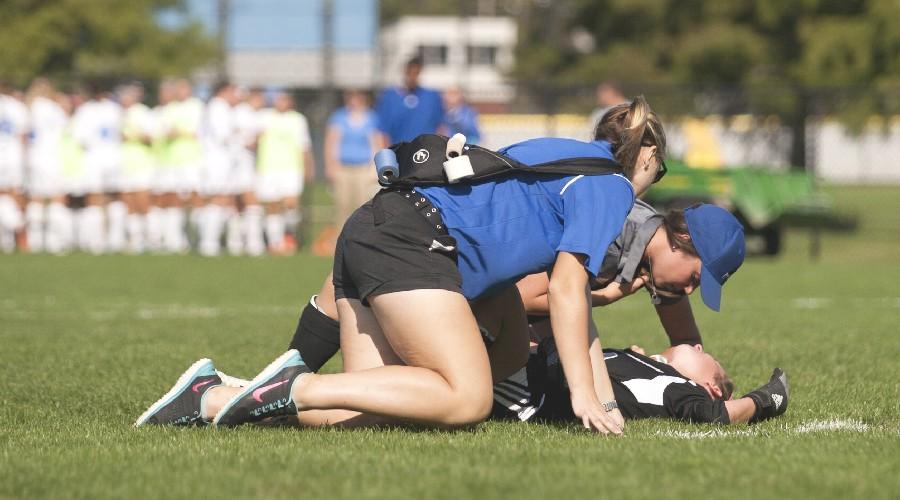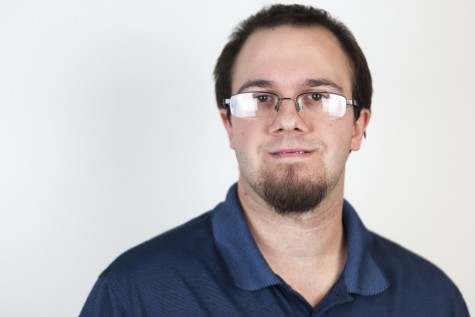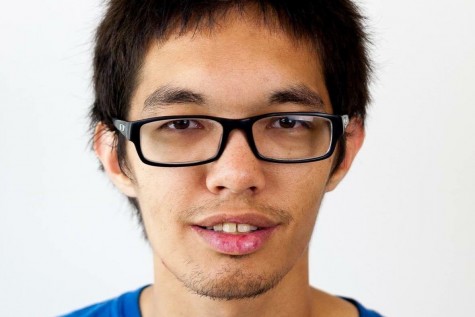Communication, flexibility help athletic trainers succeed
An Eastern athletic trainer and student trainer check red-shirt sophomore goalkeeper Kylie Morgan after she collided with a Valparaiso opponent during a game on Sept. 19 at Lakeside Field. Morgan was taken off the field and did not return to the game.
February 26, 2015
Athletic trainers do not have a set schedule, and always have to expect the unexpected.
The same can be said for Eastern’s athletic trainers, who have to have the ability to adapt to changes, especially those that come on short notice.
“Flexibility is very important in athletic training,” assistant athletic trainer Jason Heiar said. “Schedules can change, weather can change, and other variables outside your control can change the day pretty quickly.”
Heiar is the only full-time trainer for the Eastern football team, but he has two graduate assistants who work alongside him throughout the season. One of those graduate assistants is Nick Rardin, who came to Eastern after receiving his bachelor’s degree from the University of Minnesota-Duluth.
“I absolutely love my job and I love coming to work every day,” Rardin said. “I love coming to work, and getting those guys back out there when they’ve been injured. Even maintaining or keeping their strength up so that they can continue playing, while injured.”
Rardin has well over 3500 hours of athletic training under his belt while pursuing his masters at Eastern. This semester Rardin has been working with men’s basketball as well as men’s and women’s tennis teams. He said that being a good communicator with the players and coaches is also important in the training field.
That is something that fellow trainer, Daniele Petty, agreed with and said the relationship between the players, coaches and trainers is similar to that of a giant family.
“You have to have a good relationship with the athletes or they just won’t trust you,” Petty said. “You have to have good relationships with the coaches or else they won’t trust you. You just try to get as much done as possible, in as little time as possible.”
Petty is now a full-time trainer, after receiving a bachelor’s degree from Eastern and a master’s degree from Texas State University. She is the trainer for the women’s basketball and soccer teams this year.
“Every day is different. You don’t go into the same, boring nine-to-five type job,” Petty said. “One day may be qualified as boring, and the next day will be exciting. It’s kind of funny that a bored athletic trainer is a good athletic trainer.”
Heiar, who got his degrees from the University of Iowa and Syracuse University, said there is no such thing as a typical day for an athletic trainer, but most of a trainer’s routine depends on the type of season or year they’re involved in.
The football team will have weight lifting or conditioning sessions in the morning during the summer , followed by other teams. Treatments and administrative responsibilities follow throughout the day.
“We all have different schedules and travelling with different teams and so communication,” Heiar said. “Teamwork is very important for the continued care of the athletes that are not travelling or are practicing with other teams.”
Rardin said juggling school work and his athletic training duties are is the most difficult thing to deal with on a daily basis. Rardin is taking nine credit-hours this semester, which is the minimum for a Sports Management graduate assistant. He spends mornings and slow hours in the training room finishing homework, which he said he cannot wait to be rid of.
“That’s the part I’m most looking forward to when I graduate, to not have to worry about the homework aspect,” Rardin said.
Rardin hopes to find professional work back home in Minnesota; however, he realizes that is a goal that might not happen within five to ten years.
“I do miss my wife and my dog back in Minnesota once in a while. Whenever I come home they’re always happy to see me,” Rardin said. “We’re hoping to stay in the Midwest, but we’ll see.”
Problems occur in athletics just like they do in everyday life. The trainers are able to help solve those problems, give assists to those who need, and recommendations if particular care is needed.
“I look at my position as a hobby where I enjoy doing what I do and I get paid for doing it.” Heiar said.
He said Working with long term rehabs and designing exercises or drills to challenge the athlete on the road to recovery is rewarding, and one of the best parts about the job.
Blake Nash can be reached at 581-2812 or banash@eiu.edu.






































































